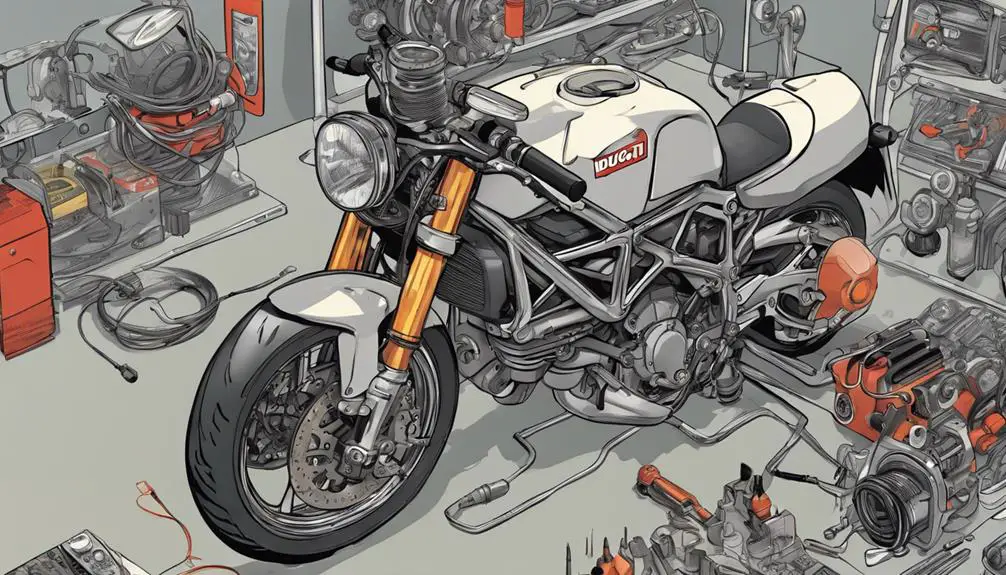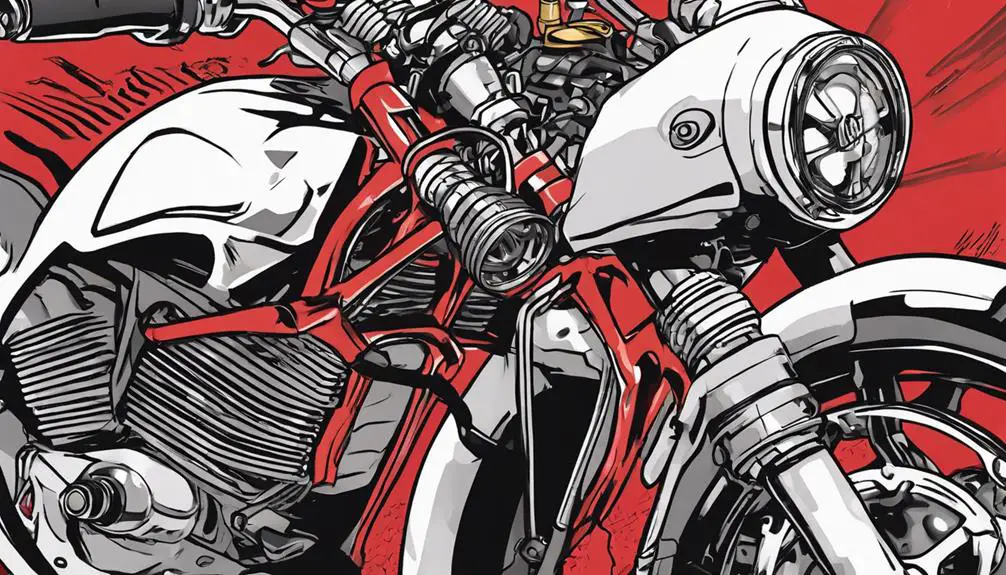Picture yourself cruising down a winding road, the roar of your Ducati echoing through the mountains, but suddenly, you feel that telltale slip in your clutch. It's a frustrating moment, and it can happen to anyone. You might be wondering how to regain that smooth, responsive ride you cherish. From adjusting the clutch cable tension to inspecting the hydraulic system, there are effective solutions to contemplate. Each option offers its own benefits, but knowing which one to tackle first can make all the difference in your riding experience.
Key Takeaways
- Regularly adjust the clutch cable tension for smooth operation and to prevent stiffness during gear shifts.
- Replace worn clutch plates to eliminate slipping and enhance acceleration and control.
- Inspect and maintain the hydraulic system to ensure proper fluid levels and avoid performance issues.
- Soak new clutch plates in oil before installation for optimal seating and longevity.
Adjusting Clutch Cable Tension

To guarantee smooth clutch operation, you'll want to adjust the clutch cable tension regularly. A properly adjusted clutch cable guarantees that you have the freedom to shift gears effortlessly, giving you the control you crave while riding your Ducati. If you notice a lack of responsiveness, it's time to take action.
Start by locating the adjuster at the clutch lever. You'll find a lock nut and an adjuster screw. Loosen the lock nut and turn the screw to either increase or decrease the tension. You want to feel a slight resistance when you pull the lever, but it shouldn't be stiff. Aim for a tension that allows you to engage and disengage the clutch smoothly, allowing you to liberate your riding experience.
After adjusting, tighten the lock nut back into place and test the clutch action. If you're still not satisfied, repeat the process. Remember, regular adjustments not only enhance your performance but also prolong the lifespan of your clutch components.
Replacing Clutch Plates
Replacing clutch plates on your Ducati can rejuvenate your bike's performance and guarantee smooth gear shifts. When you're ready to embrace the freedom of the open road, ensuring your clutch is in top shape is essential. Here's what you need to know about replacing those plates:
- Enhanced Performance: Fresh clutch plates can eliminate slipping and improve acceleration.
- Better Control: A responsive clutch lets you shift with confidence, enhancing your riding experience.
Before you engage in the replacement process, make sure you've got the right tools and parts. First, drain the oil and remove the clutch cover.
Once you're in, take out the old plates and inspect the basket for any damage. Installing the new plates is straightforward—just make sure they're oriented correctly.
Don't forget to soak the new plates in oil before installation; this helps them seat properly.
With the right approach, you'll feel the difference immediately. Embrace the thrill of riding with a revitalized clutch that responds to your every command!
Inspecting Hydraulic System

After confirming your clutch plates are in good condition, it's time to turn your attention to the hydraulic system, as it's important for smooth clutch operation.
Start by checking the hydraulic fluid level in the reservoir. If it's low, top it off with the recommended fluid. A proper fluid level is essential for maintaining that liberating feel when you shift gears.
Next, inspect the hydraulic lines for any signs of wear or leaks. Look for cracks or bulges that could lead to failure. If you spot any issues, it's imperative to replace those lines to avoid compromising your clutch performance.
Don't forget to check the master cylinder and slave cylinder as well. Make sure they're free of contaminants and operating smoothly. A sticky cylinder can create a frustrating experience, hampering your freedom on the road.
Frequently Asked Questions
What Are Common Symptoms of Clutch Issues on Ducati Motorcycles?
When you're riding your Ducati, you might notice some telltale signs of clutch issues. You may feel slipping when accelerating, difficulty shifting gears, or a spongy lever.
If you hear unusual noises like grinding or rattling, it's time to pay attention. You could also experience unresponsive engagement, where the bike doesn't respond as it should.
Recognizing these symptoms early can help you maintain your freedom on the road.
How Often Should I Check My Ducati's Clutch System?
You should check your Ducati's clutch system regularly to guarantee smooth rides and prevent issues. Aim for inspections every 1,000 miles or before long trips.
Pay attention to any changes in feel or performance—those can signal trouble. If you notice any unusual noises or slipping, don't hesitate to take a closer look.
Keeping your clutch in top shape not only enhances your riding experience but also sets you free to enjoy your journey!
Can I Use Aftermarket Parts for My Ducati Clutch Repair?
Can you really trust aftermarket parts for your Ducati clutch repair?
While they can offer cost savings and performance boosts, you've got to be cautious.
Not all aftermarket options match the quality of OEM parts, which can lead to bigger issues down the road.
Always research reputable brands and read reviews before making a decision.
Choosing wisely can help you maintain that exhilarating ride you crave while keeping your bike in top shape.
What Tools Do I Need for Ducati Clutch Maintenance?
For Ducati clutch maintenance, you'll need a few essential tools.
Start with a socket set to remove the clutch cover and bolts. A torque wrench guarantees you tighten everything correctly.
You'll also want a flathead screwdriver for any adjustments.
Don't forget a clean workspace and some rags for any spills.
If you're feeling adventurous, a service manual can guide you through the process, helping you feel empowered while maintaining your ride.
Are There Any Recommended Lubricants for Ducati Clutch Systems?
Have you ever wondered how the right lubricant can transform your ride?
For Ducati clutch systems, using high-quality synthetic oils is essential. Look for products specifically designed for wet clutches, like Motul 7100 or Shell Advance.
These lubricants provide excellent protection and enhance performance, ensuring a smoother engagement. Avoid using automotive oils as they can cause slippage.
Conclusion
In summary, tackling clutch issues on your Ducati is essential for peak performance.
Did you know that improperly adjusted clutch cables can reduce your bike's responsiveness by up to 30%?
By regularly adjusting the cable tension, replacing worn clutch plates, and inspecting the hydraulic system, you can greatly enhance your riding experience.
Don't wait for problems to escalate—stay proactive and keep your Ducati running smoothly for every twist and turn on the road!